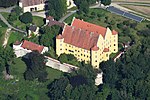Rot (Danube)
Rivers of Baden-WürttembergRivers of GermanyTributaries of the Danube

The Rot is a southern tributary of the river Danube in the region of Upper Swabia in Baden-Württemberg in Germany. It has a length of 56 km. The Rot runs in a northerly direction parallel to the river Iller to the east, and Westernach to the west. Both these rivers are also tributaries to the Danube.
Excerpt from the Wikipedia article Rot (Danube) (License: CC BY-SA 3.0, Authors, Images).Rot (Danube)
Donauallee,
Geographical coordinates (GPS) Address Nearby Places Show on map
Geographical coordinates (GPS)
| Latitude | Longitude |
|---|---|
| N 48.313055555556 ° | E 9.9 ° |
Address
Donauallee
Donauallee
89155
Baden-Württemberg, Germany
Open on Google Maps








